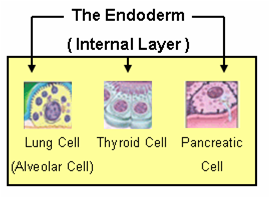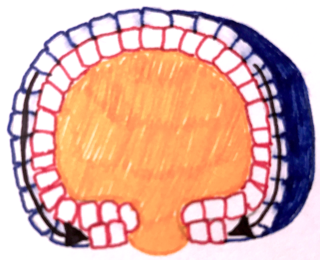 W
WIn developmental biology, gastrulation is a phase early in the embryonic development of most animals, during which the blastula is reorganized into a multilayered structure known as the gastrula. Before gastrulation, the embryo is a continuous epithelial sheet of cells; by the end of gastrulation, the embryo has begun differentiation to establish distinct cell lineages, set up the basic axes of the body, and internalized one or more cell types including the prospective gut.
 W
WThe dorsal lip of the blastopore is a structure that forms during early embryonic development and is important for its role in organizing the germ layers. The dorsal lip is formed during early gastrulation as folding of tissue along the involuting marginal zone of the blastocoel forms an opening known as the blastopore. It is particularly important for its role in neural induction through the default model, where signaling from the dorsal lip protects a region of the epiblast from becoming epidermis, thus allowing it to develop to its default neural tissue.
 W
WThe ectoderm is the most exterior of the three primary germ layers formed in the very early embryo. The other two layers are the mesoderm, and endoderm. It emerges and originates from the outer layer of germ cells. The word ectoderm comes from the Greek ektos meaning "outside", and derma meaning "skin."
 W
WEndoderm is one of the three primary germ layers in the very early embryo. The other two layers are the ectoderm and mesoderm, with the endoderm being the innermost layer. Cells migrating inward along the archenteron form the inner layer of the gastrula, which develops into the endoderm.
 W
WEpiboly describes one of the five major types of cell movements that occur in the Gastrulation stage of embryonic development of some organisms. Epibolic movement is the way in which a layer epithelial cells spreads. This can be achieved in multiple ways.
 W
WIn avian gastrulation, Koller's sickle is a local thickening of cells at the posterior edge of the upper layer of the area pellucida called the epiblast. Koller's sickle is crucial for avian development, due to its critical role in inducing the differentiation of various avian body parts. Koller's sickle induces primitive streak and Hensen's node, which are major components of avian gastrulation. Avian gastrulation is a process by which developing cells in an avian embryo move relative to one another in order to form the three germ layers.
 W
WThis is a list of cells in humans derived from the three embryonic germ layers – ectoderm, mesoderm, and endoderm.
 W
WIn all bilaterian animals, the mesoderm is one of the three primary germ layers in the very early embryo. The other two layers are the ectoderm and endoderm, with the mesoderm as the middle layer between them.
 W
WVegetal rotation is a morphogenetic movement that drives mesoderm internalization during gastrulation in amphibian embryos. The internalization of vegetal cells prior to gastrulation was first observed in the 1930s by Abraham Mandel Schechtman through the use of vital dye labeling experiments in Triturus torosus embryos. More recently, Winklbauer and Schürfeld (1999) described the internal movements in more detail using pregastrular explants of Xenopus laevis.